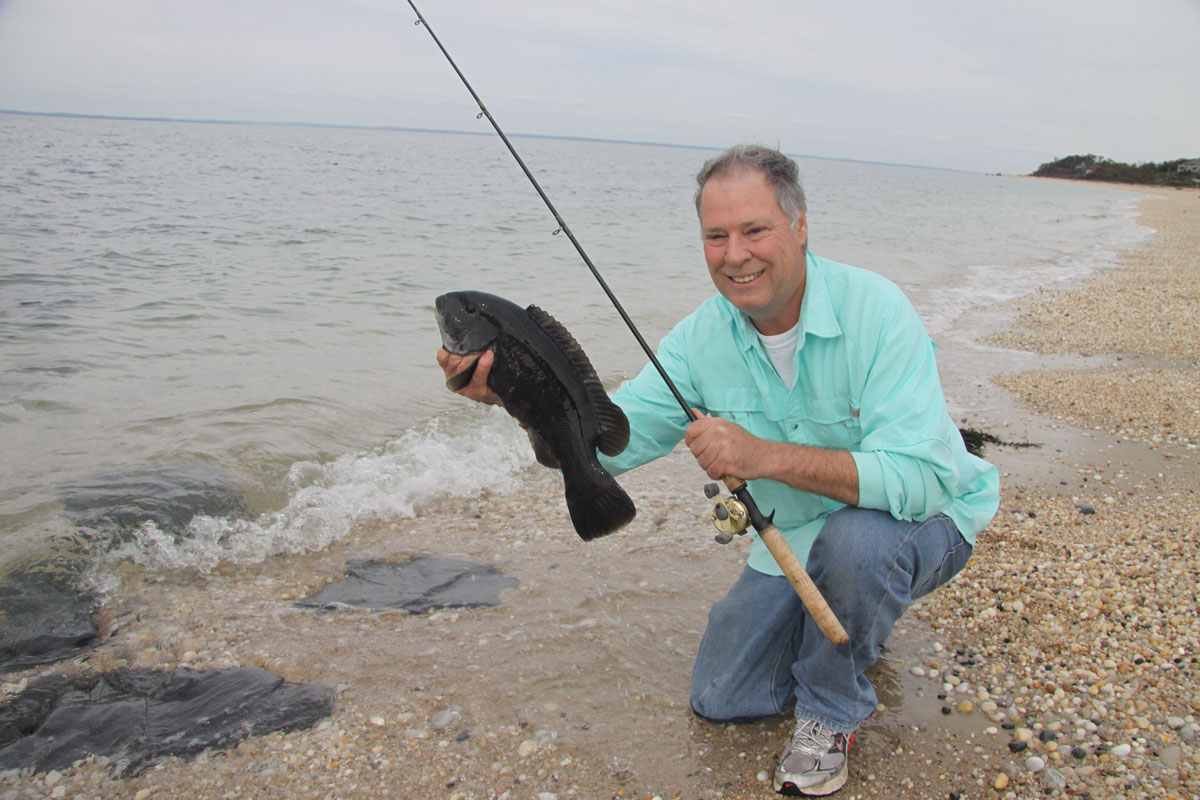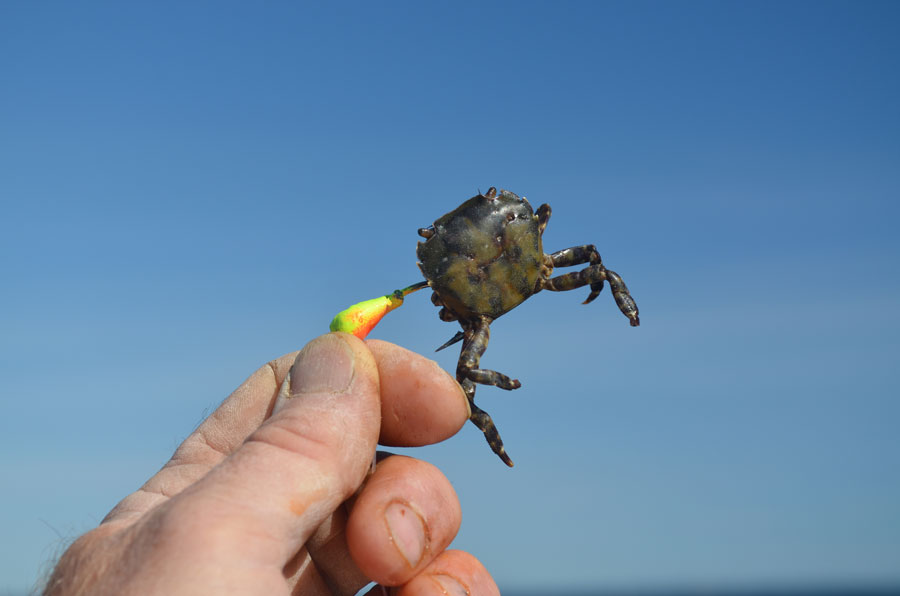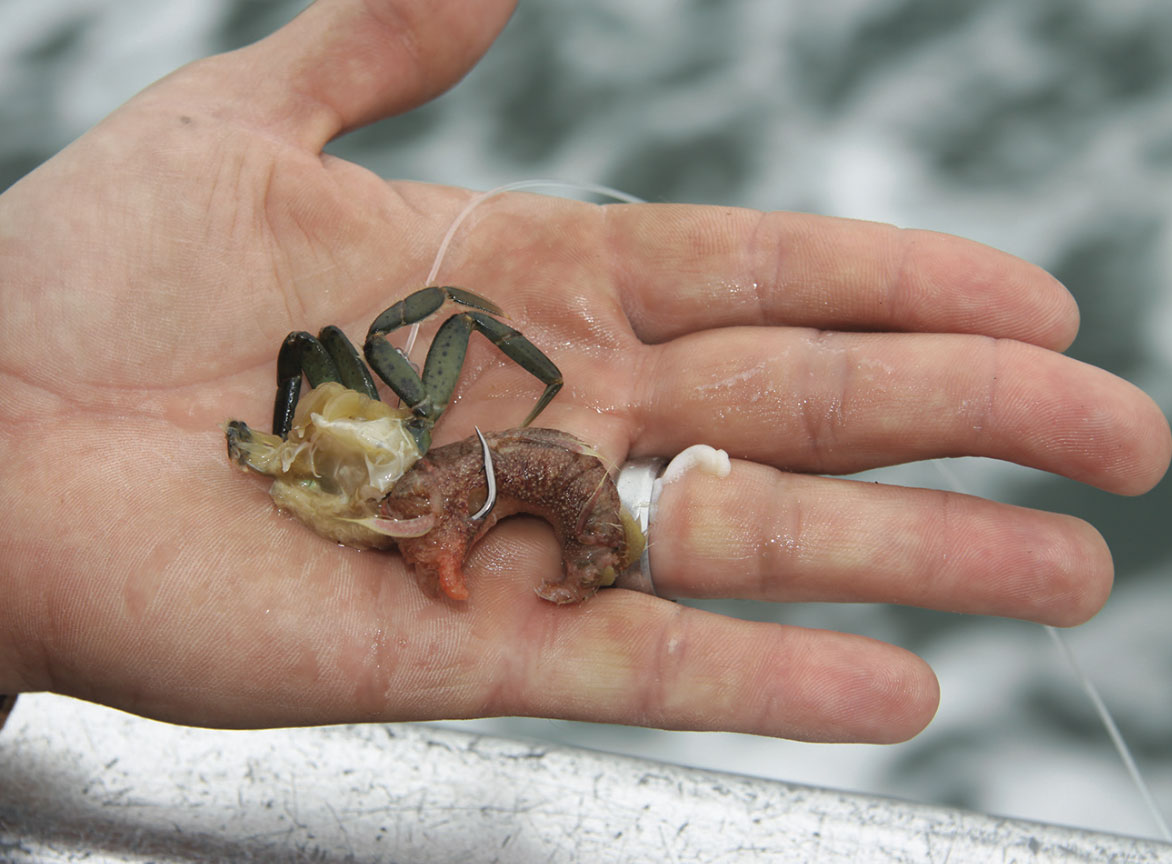By Tom Schlichter

All the excitement about anglers catching blackfish on jigs over the past few years has many bottom bouncers rearing to go this fall with some fresh perspectives. The technique, in which anglers simply tip a jig designed especially for tautog with a small crab and lower it to the bottom without a sinker, allows for a more sensitive feel and direct tussle once the hook has been set. In short, it makes blackfishing even more fun than usual because anglers can use spinning and lightweight conventional gear with braided lines to really feel the power of a bulldog in depths of 30 feet or less.
With today’s improved braided lines, increasingly powerful reels and super sensitive, super strong spinning rods, blackfish has never been more fun. To really up your game and put both your skills and tackle to the test, here’s a couple of radical blackfishing approaches to consider once you’ve already put a few fillets in the cooler this fall.
SIGHT FISH THE INLETS!
Sight fishing for blackfish? You bet. It works along the rock jetties and rip-rap edges of inlets, and along rock-lined Long Island Sound harbor mouths and break walls as well.
The key is to this approach is to notice when the water becomes gin-clear as cooler temperatures begin to kill off summer algae. Usually, this happens during early to mid-October. With visibility that allows a good look at the bottom in water depths of six feet or more, you can stake out a likely looking section and wait for blackfish to arrive in search of crabs, mussels and grass shrimp. Generally speaking, the ‘tog edge into these areas during the last hour of rising water and hang around through slack tide into the first hour of the ebb. If you can combine that tide slot with dawn or dusk on a quiet mid-week day when boating and jetty traffic are minimal you can come away with some surprising success.
This is really a bait and wait game. Look for submerged outcroppings among the rocks, grab a seat and watch quietly to see if any blackfish find their way to the edge. At first you might see a few shadows along the bottom near the deepest rocks or boulders. Stay put, keep still and, after a few minutes, the blackfish should begin working their way up along the edge, picking at crabs and tidbits at a casual pace. I’ve caught keeper blackfish using this technique in water as shallow as three feet and have frequently connected in four- to six-foot depths over the years.

As you see the fish working up the edge, gently cast an un-weighted crab well beyond the rocks, then reel it in slowly to lead the fish by several feet. Allow the crab to settle in against the rocks and then watch as a blackfish casually strolls over to check it out. Because you can see the bite (polarized sunglasses help,) make sure to give the fish a second or two to get the crab deep in its mouth before striking. While crabs are my favorite bait for this because they hold up well if smaller fish are also on the edges, a whole chowder clam body is something no blackfish can pass up.
Try to target a specific fish when you use this technique, because the ‘tog can grow cautious after one or two have been picked from the rocks. If the fish suddenly vanish, wait five or ten minutes and it is likely they’ll return. Always target the biggest fish first.
FLIP THE BOULDERS
A challenging technique that works from kayaks or small boats – and occasionally from rocky beaches – is to flip for blackfish around boulders. This is pretty-much a Long Island Sound approach, and it works best when working around large boulders that breaks the surface in six- to 20-foot depths.
As with working jetties, this technique is best applied at the top of a flooding tide, during slack water and at the very beginning of the ebb. Tie a standard bottom rig with a #2 Virginia style blackfish hook and one-ounce bank sinker. Approach the boulder from upwind or up-current, and simply flip a crab bait against the rock. Let the bait settle to the bottom and be ready for a quick strike. If no hit ensues after a minute or so, reel up, and flip the bait a few feet further along the perimeter of the boulder.
Most of the blackfish you’ll score with this approach will come from the up-tide side of the boulder, but probe the sides and down-tide pockets as well. It’s important with this technique not to allow the rig to drift with the boat to avoid snags. In fact, it’s best to leave a little slack in the line and watch for twitches rather than keeping a tight line that will eventually drag the sinker into a pinch-point. If you see the line twitch, tighten slowly, feel for weight – and then set the hook hard.

PROBE THE DOCKS
It always amazes me how fall anglers fishing from docks inside bays and harbors try to cast as far out as possible. Certainly, if you are looking for stripers, bluefish and fluke there is something to be said for covering a lot of water. With blackfish, however, prime real estate is always within a few feet of structure. Examine docks and bulkheads for any stretch that sports a busted plank or two, a section that sticks out into strong current, or a significant drop-off. These are the spots on which to concentrate your efforts.
Docks and piers afford anglers a chance to catch blackfish without having to deal with a lot of snags, which means that you can fish with lighter gear. Look for ‘tog to set up in areas where the shape of your fishing platform blocks or deflects the current. Be aware, too, that blackfish will often swing from one side on an obstruction to the other as the tides change. If you’ve been catching them on one side of dock on incoming water, expect the fish to stack up on the opposite side as the ebb begins to flow. It’s not a hard and fast rule, but it holds true more often than not.
To be sure, none of these techniques are as productive as setting up at anchor over a high profile mussel bed, wreck or reef. They are, however, challenging, fun and different enough to pique the curiosity of blackfish fans with a hunkering to try something new. Early October is prime time for these shallow water techniques, so spool up with some 30-pound test braid, grab a lightweight rod with decent backbone, and head out to give these new tricks a try. You may find the thrill of the hunt to be even more fun than the nearly guaranteed catches of more traditional approaches.
By Tom Schlichter









